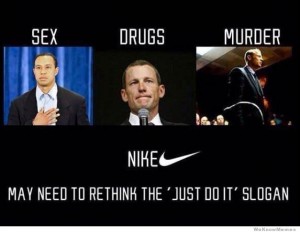#4 – Failed Endorsements: Lose-Lose Situation for Nike?
The Oscar Pistorius case that occurred last month doesn’t just have Reeva Steenkamp’s family in mourning. This is Nike’s third major case of athlete endorsement gone wrong ever since the Tiger Woods sex scandal in 2009. Woods, Lance Armstrong (for doping), and now Oscar Pistorius – the “bladerunner” paralympian who made headlines last year after he competed in the London Olympics – have all gotten in trouble with the law and have turned Nike’s multimillion dollar investment sour (11% of their $8.4 billion advertising budget was spent on endorsements).
From a marketing standpoint, the decision whether to keep these athletes on Nike’s endorsement payroll is an incredibly tough decision. They cut ties with Armstrong and Pistorius almost immediately. However, they decided to keep Woods on their payroll and have since re-branded him. They released the controversial commercial below, re-positioning Tiger as someone who is human and makes mistakes – a stark contrast to the God-like status Nike bestowed on him before.
[youtube=https://www.youtube.com/watch?v=5NTRvlrP2NU]
Since then Nike has slowly moved back to focusing on Tiger as a golfing figure, recently airing a commercial with another Nike signing: Rory MacIlroy:
[youtube=https://www.youtube.com/watch?v=2NCDYjHtEcU&list=PL82EB32A8DE8F2E55&index=2]
In the end, I look at their decisions on what to do with athletes who have gained negative pr as one based on value. Armstrong and Pistorius are icons, no doubt. However, Armstrong is retired and was more of a spokesperson who’s image was based on the integrity he’d built up in his career. By admitting to using performance-enhancing drugs, he effectively eliminated that integrity – Nike’s asset in the partnership. Pistorius, meanwhile, proved to be expendable. An unfortunate timing with his murder trial – Nike had drafted up an ad with Pistorius before the events with the words “I am the bullet in the chamber” – coupled with that fact that he isn’t as on high a level as some of Nike’s other athletes, meant that the future value just wasn’t there. Woods meanwhile, hasn’t lost what made him so marketable in the first place – his golf talent. That, coupled with the fact that he is one of the most recognizable people in the world, meant that there was still marketing value to be had from keeping Woods with Nike.
For more on the Nike endorsement story, check out this article by Gabrielle Douglas (Associated Press)
 Comments(0)
Comments(0)